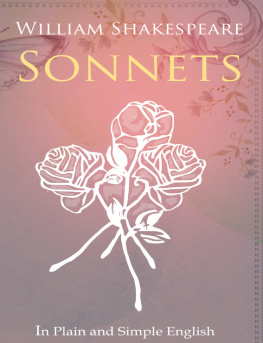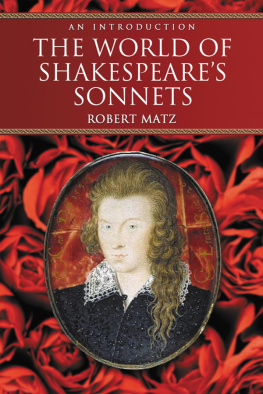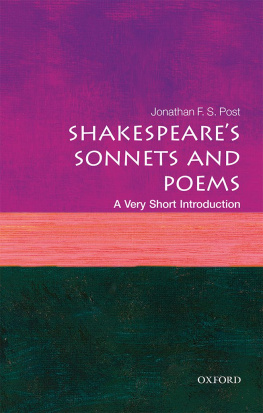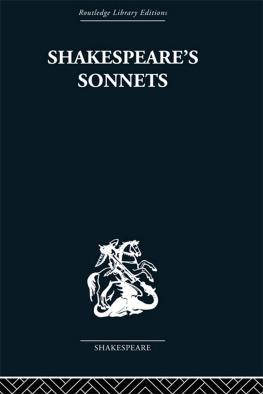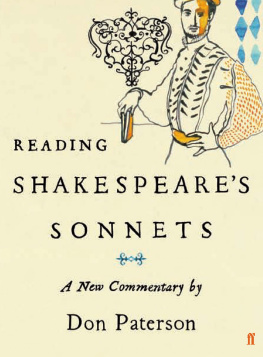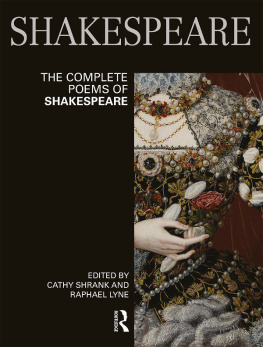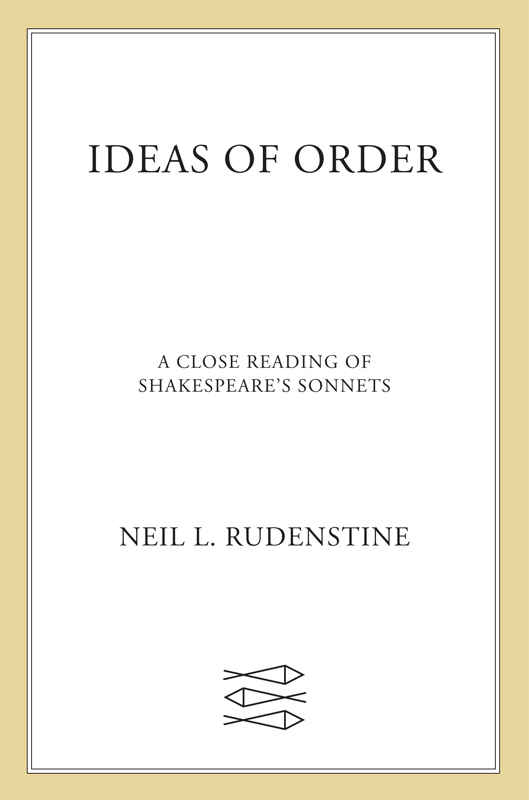Contents
Guide
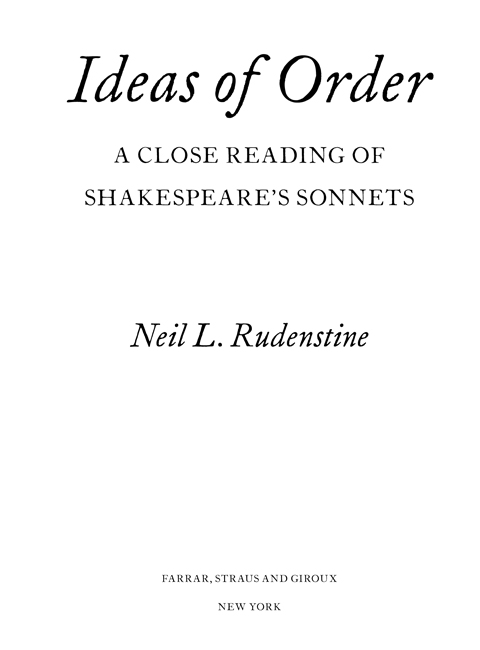
The author and publisher have provided this e-book to you for your personal use only. You may not make this e-book publicly available in any way. Copyright infringement is against the law. If you believe the copy of this e-book you are reading infringes on the authors copyright, please notify the publisher at: us.macmillanusa.com/piracy.
For Antonia, Nicholas, and Sonya
Contents
A Note on the Text
During the course of writing this volume, I have consulted several editions of the Sonnets, using the 1609 version as a constant reference point. Colin Burrows excellent edition (New York: Oxford, 2002) has been especially helpful, but no single version has been followed. When faced with important differences among authorities, I have made my own choices.
ONE
Inner Order
Shakespeares Sonnets are the greatest single work of lyric poetry in English, and many of the individual poems are as powerful as those in any language. Yet they are scarcely read, except for the few that are regularly anthologized. This is not necessarily surprising. The vogue for sonnets reached its height in England during the last decades of the sixteenth century, and while many major writersincluding Milton, Wordsworth, Keats, Frost, and Audenhave at times used the form to great effect, it remains a rarity, especially in modern literature.
To be confronted with a sequence of 154 sonnets, therefore, is a considerable challenge, particularly if the poems are as complex as any work written by Shakespeare. To try to take the measure of each of these poems is an exercise for adventurous but also patient spirits. To grasp the contours of the sequence as a whole requires no less concentration. The effort, however, is more than simply rewarding, because the work consists of love poetry that is as passionate, daring, intimate, searing, and lyrical as any that we may ever encounter.
This book is intended as an introduction for readers who may have an interest in the Sonnets themselves, or in Shakespeares work as a whole, or simply in lyric poetry. It makes no attempt to survey the broad range of comparatively recent interpretations, but does argue that the Sonnets are more carefully orderedas a coherent sequencethan is the case in most other works of criticism and scholarship.
* * *
A number of the best Shakespearean scholars haveover a great many yearsshown how little evidence exists to support any number of hypotheses put forward by commentators with an interest in the historical or biographical background of the Sonnets. But these efforts were, for a very long time, largely ignored. The situation was such that in 1964 when W. H. Auden published an introduction to the sequence, he began not with the usual generalizations that characterize such essays, but with a full assault:
Probably, more nonsense has been talked and written, more intellectual and emotional energy expended in vain, on the sonnets of Shakespeare than on any other literary work in the world It so happens that we know almost nothing about the historical circumstances under which Shakespeare wrote these sonnets: we dont know to whom they are addressed or exactly when they were written, and unless entirely new evidence should turn up, which is unlikely, we never shall.
Audens piece was a swashbuckling venture in which he tried to scatter the tribes of all those who have searched, without persuasive results, for the person who is enigmatically called the Onlie Begetter of the poems, and whose initials (on the title page of the 1609 original edition) are Mr. W. H. Auden also tried to sweep away speculation about the origin of the various characters in the Sonnets, including the young man (with whom the poet is in love); the so-called dark lady (the poets mistress and object of his lust); and the rival poet with his compeers by night. There is not, as Auden and others have rightly pointed out, a reliable piece of evidence to confirm the identity of any of these figures.
Finally, Auden tried to detonate any lingering belief that the Sonnets were autobiographical in nature, although he didrather oddlyview them as a kind of diary written by the poet for himself alone. In Audens view, Shakespeare played no part in preparing the poems for publication: they were simply too intimate, and Shakespeare must have been horrified when they suddenly appeared in print.
Apart from biographical and more general historical matters, at least two other major issues have confronted commentators. These concern the order of the Sonnets and their dating. Although contemporary scholars and critics differ about the extent and nature of the Sonnets order, many would agree that there are a number of tightly linked clusters of poems that focus on either a particular situation, or incident, or themeand these clusters are clearly relevant to any intelligent reading of the entire work. Indeed, some editors, over many decades, have attempted to rearrange the sequence in an effort to create a more fully coherent and carefully structured narrative or drama. Not surprisingly, all of these attempts failed.
Sonnet sequences belong to no well-defined genre. If one compares the sonnets of Petrarch, Sidney, Spenser, Daniel, and Drayton, one grasps immediately how much latitude was offered to the poet who set out to write yet another collection. Moreover, because some (not all) of these works were written over a period of years, there was ample time for digressions, turnings, and returnings to themes and preoccupations that could be initially explored in a few sonnets, temporarily set aside, and then taken up again at a later point. In addition, inexplicable (as well as explicable) gapsor poems that seem to be entirely misplacedcan suddenly appear. As a result, the reader or critic may well conclude (as did Auden) that there is finally no clear order to Shakespeares sequence.
By contrast, Richard Blackmurs essay on the Sonnets, published in 1961, offered a view that is helpful in a number of respects:
No one can improve upon the accidentally established order we possess; but everyone can invite himself to feel the constant interflow of new relations, of new reticulationsas if the inner order were always on the move Furthermore the sequence we have seems sensible with respect to [the poems] sentiments, and almost a desirable sequence with respect to the notion of development.
For Blackmur, the unfolding pattern of the Sonnets sentiments and the arc of the works development seemed right. He believed that the order of the poems reflected Shakespeares intentions, and he proposed that those who disagreed should try reading the poems in reverse order: They will turn themselves round again of their own force. Although Shakespeares role in arranging the poems remains open to speculation, some of the clusters of linked sonnets seem so tightly bound together that it is hard to imagine he played no substantive part in their formation.
If Shakespeare was concerned about giving some discernible shape to the Sonnets, there is no way to settle the question of his role in their publication. Perhaps his informal audience of friends was sufficient. Circulating ones poems privately was of course not unusual during the Elizabethan period: Sidney certainly showed no interest in publishing his own sonnet sequence, Astrophil and Stella , and Donne would almost certainly have been embarrassed to see his Songs and Sonnets in print. With respect to Shakespeare, there is simply no way to reach a persuasive conclusion: the case remains open, and is likely to remain so.


